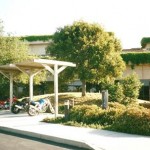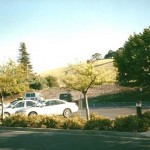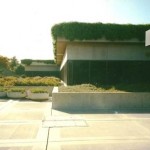The need for reinvention
In his lab a few doors along the corridor from his office, Biegelsen proudly shows a piece of paper being steadily rotated by jets of air, held between two green printed circuit boards, while the paper’s movement is monitored on a PC. This is one of Parc’s big current projects – to reinvent the printer, like it did in 1971.
Chris Chau, a 33-year-old researcher, explains why Biegelsen’s jet paper mover will be needed: mechanics will not be able to move paper fast enough to cope with the printing speeds Chau is working on, only air-jets will suffice. Chau has created the world’s most densely-packed laser array: a one centimetre square of silicon chip containing 10,000 lasers, each the size of a red blood cell. This order of lasers could print an entire page’s width simultaneously: with just two lasers, Parc has already reached 180 pages per minute. Parc staff describe the project as “Bat out of Hell printing”.
Both the paper jet and the laser array are Microelectromechanical Systems (Mems): they incorporate mechanical features into microchips and printed circuit boards, allowing miniaturisation, integration with electronics and big manufacturing savings. Chau is passionate about the potential wider aspects of his laserchip in military communications. “All transceivers use these kinds of lasers. If you can send signals through one fibre, what about sending a thousand signals through a thousand lasers?” he asks. “Except at Xerox, our main product is printing,” he adds, gazing out of the window.
And this is where the majority of innovation is now focused – on printing and related projects, such as digital paper – a material which can be “printed” upon by changing the alignment of millions of tiny globes inside, then wiped and reused repeatedly.
Xerox is keen to partner and spin-off companies to exploit whatever technologies Parc comes up with. The newest playmate is Microsoft, and the joint venture ContentGuard. Microsoft is taking an eight-figure stake, and will incorporate its products throughout its software. ContentGuard uses an XML-like language to track and control viewing and printing of material, a concept called document rights management. Online publishers could charge users every time they read something, let them print a story once only, or permit free access – just for a week.
David Biegelsen believes ContentGuard builds on the original aims of Ears to open up computing to the masses, only this time it’s publishing that is getting the Parc treatment. “It’s absolutely the same sort of project,” he asserts. “It means everyone can be a publisher and get royalties – think billions of publishers. We’re going to give people the right to keep the rights to their ideas. We have to spin it out to do it, but that’s what the new economy seems to require.”
Well, maybe: and it is reassuring that Parc researchers still grapple with the social implications of their work. But if it becomes pervasive (and why else would Microsoft be involved), ContentGuard would suck power from the reader to the author, from the individual to the centre. This is surely the opposite of Ears’ Utopian aim, and indeed Xerox’s breakthrough product the photocopier, which helped information in its desire to become free long before the Internet.
Perhaps it is unfair to blame Parc for any excessive control that ContentGuard will help authors exert over their work. Consider what people did with the Ears technology when it finally reached the market at a reasonable price, in the guide of an Apple Macintosh. Did they create peace and love? Or did they use its spreadsheet software to calculate leveraged company buy-outs and downsizing programmes?
Ears did indeed empower individuals to take control of their lives. Unfortunately or thrillingly – depending on your politics – it helped empower a few individuals to become unfeasibly rich. Entrepreneurs with tiny companies became multi-billion dollar enterprises without needing many employees or suppliers with whom to share the wealth. Everyone outside got relatively poorer: and that includes Parc researchers.
Relative poverty is a big issue around Parc – because the soaraway property prices turn “relative” into “actual” pretty quickly. The trees in Chau’s view hide the housing of Santa Clara County, where the average property price is north of $500,000 and rising fast. Chau lives on the less expensive south side of San Jose, and gets a half-hour express bus into work. Prosperous Americans do not, as a rule, take buses. “The housing around here is too expensive,” Chau explains. “You have to be dot com millionaire to live here.” Management are working on this problem.
“Is there a big impact, from this ‘get-rich-tomorrow’? Of course,” says Xerox’s senior vice president for research and technology Hervé Gallaire. “Xerox will respond to that. Rick [Thoman, chief executive of Xerox] has asked me to think through what we need to do as a company to retain the best talent.” This will probably include ways for the researchers to share in the winnings if their inventions hit the big time, including more spin-offs such as ContentGuard.
Thinking ahead
Parc hasn’t given up trying to create the future. “I would hope that by 2030, we have replaced the desktop with something radically new, that would integrate, work across the world, give access to anything you need, but provide you only information relevant to you,” says Gallaire. “And I would look to our printing systems to have no moving parts, be completely electronic, highly reliable, and all-colour at a cost that’s open to everybody.” He adds that speculative research is still being done, and that there is amazing work under wraps: “If I described it, you would say, ‘that’s blue sky’.”
However, even Gallaire suspects the Ears achievement of the 1970s cannot be repeated. “Can Parc change the whole landscape, networks, printers, the whole thing? I don’t think so,” he says. “I hope I will be contradicted.” Gallaire’s strategy is to organise teams of Parc researchers with Xerox’s other bases at Webster in New York state, Cambridge in the UK, and others in France, Canada and the US.
Michael Hiltzik, who writes for the Los Angeles Times about technology and last year published a study of Parc, says: “I don’t know where a future Parc will come from, as no corporation, in this country at least, is willing to go to shareholders and say, we’ll fund these people from outside the company who are just instilled with basic science.” The problem, he adds, is that anyone with a scrap of a good idea wants to stop researching, launch a company and fling a product out as soon as possible. Biegelsen agrees: “You get lots of little ideas occurring in garages, but to make ideas develop between things, you need companies with a monopolistic position,” he says, referring to Xerox’s stranglehold on photocopying when Parc was established. “You need to have money lying around. So it’s really a concern, that people get sucked out of universities, leaving the sources of that kind of thinking and serendipity dry.”
Biegelsen says he has no interest in getting rich. “It doesn’t motivate me. To me, this is an ideal job in an ideal setting.” But then, when he bought a house locally, he put down $6,000 to buy 20%. Biegelsen can afford to be relatively poor.
Can his replacement?
Invented here
Parc claims first realisation of the following, although some were conceived elsewhere.
● Screen windows: First demonstrated by Doug Engelbart in December 1968, but made feasible with relatively small amounts of memory by using management software Parc that developed.
● The mouse: Another Engelbart innovation that Parc made work.
● Laser printers: Gary Starkweather thought up the idea while working at Xerox’s main lab in New York state, but was prevented from working on it. Luckily, he was transferred to Parc, where he completed his invention.
● Wysiwyg word processing: What You See Is What You Get was created at Parc, although its inventor then jumped ship to Microsoft – which then created Word. Previously (and indeed in green-screen computers from the 1980s such as Amstrads), computer screens used the same font for all characters, with “bold” or “italic” only indicated by onscreen codes.
● Silicon Valley: Although some firms were already located in what was, in 1970, called the Santa Clara valley, Parc certainly helped give the area weight from a technical point of view.
Timeline of Xerox Parc
● December 1968: Doug Engelbart demonstrates NLS (oNLine System), including the first demonstration of a mouse – made from a hollowed-out block of wood – split-screen windows and multi-media, at the Fall Joint Computing Conference in San Francisco.
● July 1969: Alan Kay suggests elements of the Dynabook in his doctoral dissertation for Utah University. He describes this as a “personal computer” in his job interview for Parc.
● January 1970: George Pake joins Xerox as director of its new lab. He chooses a base near Stanford University on the outskirts of Palo Alto.
● July 1, 1970: Parc officially opens.
● June 1971: Alan Kay leads a team working on Smalltalk, its object-oriented programming language.
● November 1971: Gary Starkweather completes the first laser printer.
● 7 December 1972: ‘Spacewar’ published by Rolling Stone magazine. Includes a picture of a Dynabook dummy.
● April 1973: The first Alto goes live, demonstrating an animation of the Cookie Monster from Sesame Street. It uses a black-on-white screen the size of a US standard sheet of paper, 11” high and 8.5” wide.
● May 22, 1973: Metcalfe describes Ethernet for the first time in a patent memo.
● October 1974: Charles Simonyi completes Bravo, the first Wysiwyg (what you see is what you get) word processor, for the Alto.
● February 1975: Parc engineers demonstrate a graphical user interface using icons and the first use of pop-up menus.
● 1 March 1975: Parc moves into its current home, 3333 Coyote Hill Road.
● December 1979: Steve Jobs and a team of Apple staff visit Parc. They will incorporate many of its ideas into the Apple Lisa and Macintosh.
● 30 September 1980: Xerox, with Intel and Digital Equipment, licence Ethernet for a nominal fee. It becomes, and remains, an industry standard.
● 24 August 1981: IBM launches the Personal Computer, without Star’s graphical user interface or a mouse, but with a green-on-black TV-shaped screen – but for less than $5,000.
● January 1984: Apple launches the Macintosh, for many the realisation of Parc’s work on personal computers.
Further reading
Smith, Douglas K and Alexander, Robert C, Fumbling the future: how Xerox invented, then ignored, the first personal computer (toExcel: Lincoln, Nebraska, 1999). Available from Amazon.
Hiltzik, Michael, Dealers of lightning: Xerox Parc and the dawn of the computer age (HarperCollins: New York, 1999). Available from Amazon.




